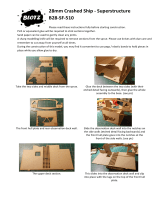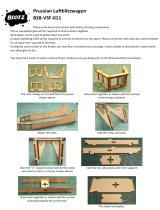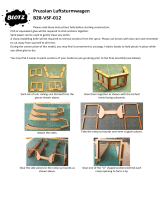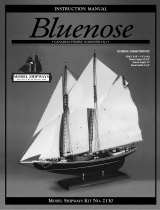Page is loading ...

Yamato: Step-by-step
Frame no. 2
Frame no. 3
Frame no. 4
Piece of reinforcement x 2
Reinforcement
Ventilation system (right)
Ventilation system (left)
Ventilation system (front)
Rangefinder
Machine gun firing
mechanism x 2
• PVA wood glue
• Metal file
• Sandpaper (grain
no. 800)
• Craft knife
• Putty
• For metal: Super Glue
Gel or Two-part epoxy
glue
• Metal mordant
• Model-making spray
paint (battleship grey)
• Model-making
watercolour
(battleship grey no. 2,
matt black)
Recommended tools and materials
Hull, ventilation system, machine gun firing
mechanism and rangefinder
13
7
Prepare the flat parts of
pieces no. 6and no. 7with
the metal file, eliminating any
projections.
6
Apply glue in the notches on
the first, second, third and
fourth frames and fix
reinforcement (5).
5
Following the same
procedure, fix the second
piece of reinforcement (4),
applying glue in the notches of
the fourth, fifth and sixth
frames.
VENTILATION SYSTEM, MACHINE GUN FIRING
MECHANISM AND RANGEFINDER
3
Similarly, apply glue in the
fourth joint from the front
of the keel and fit frame no. 4
(3) as shown in the photo.
Make sure the joint is vertically
set at 90 degrees and also square
to the keel.
4
Place a piece of
reinforcement (4) in the
notch on top of the fourth, fifth
and sixth frames. Apply glue to
the notch in each frame and fix
the piece of reinforcing, which
will reach approximately the
middle of the sixth frame (red
circle).
2
After applying glue in the
third joint from the front
end of the keel, place frame no.
3 (2) as shown in the photo.
Make sure the joint is vertically
set at 90 degrees and also square
to the keel.
1
Take the part of the hull that
you assembled in previous
steps. After applying glue in the
second joint at the front end of the
keel, fit frame no. 2 (1), as shown
in the photo. Make sure the joint
is vertically set at 90 degrees and
also square to the keel.
THE HULL

Yamato: Step-by-step 14
13
Following the technique
described in steps 7–10,
prepare the outline of pieces
no. 10. Smooth the surface of
the pieces with both the metal
file and sandpaper.
8
Smooth the entire
surface of no. 6and no.
7with sandpaper (grain no.
800). To smooth the inner
surfaces, fold the sandpaper
in two as shown in the
photo.
11
To shape the outline of
piece no. 8, lightly
smooth the flat part with the
metal file to remove any
projections.
12
Smooth piece no. 8
with sandpaper. Be
careful not to damage the
cavities necessary for the
building of the model. Fold
the sandpaper in two to
smooth the hollow parts, as
shown in the photo.
10
If there are
irregularities on the
surfaces of pieces no. 6and
no. 7, spread a thin layer of
putty over the entire surface
and, when it is dry, smooth
with sandpaper. If the putty
gives way, repeat the
operation.
15
Prepare piece no. 9
following the method in
steps 13 and 14.
9
In the places where it is
difficult to reach with
sandpaper, use a craft knife,
which can also be used to
correct the edges if they are
not well modelled. It is easier
to deal with such details if
you hold the tip of the blade
between your fingers.
14
If you should erase the
original reliefs from the
pieces no. 10, recreate them
with a craft knife.
16
Paint pieces from nos.
6to 10. First, spray
them evenly with the metal
mordant from a distance of
30cm. To avoid the pieces
moving, fix them in advance
onto adhesive tape.
17
When the mordant is
perfectly dry, paint the
pieces with battleship grey
model-making spray paint,
holding the can about 30cm
away.
When using metal mordant, ventilate the room well and follow the
manufacturer’s instructions.
When using spray paint, ventilate the room well and follow the
manufacturer’s instructions.

Yamato: Step-by-step
19
Take piece no. 6as
shown in the photo and
paint the square upper faces.
Mix an equal amount of
battleship grey and matt black
model-making watercolour.
Paint with the tip of the brush
and take small amounts of
paint to prevent smudging.
Follow the same procedure for
piece no. 7.
18
Spray several times
evenly and changing
direction, taking care not to
fill the original small reliefs.
Wait for the pieces to dry
completely.
22
Hold the command
deck as shown in the
photo. Use quick-drying glue
to fix piece no. 8under the
windows of the front area. As
can be seen in the photo, the
top of piece no. 8must align
with the lower edge of the
windows.
23
Similarly, glue piece no.
7under the window on
the left side of the command
bridge with quick-drying glue.
Match the oblique side of no. 7
with the side of no. 8. Follow
the same procedure to fix piece
no. 6on the opposite side the
bridge.
21
Paint the two lateral
cavities of piece no. 9
with matt black model-making
watercolour. Since the areas
are tiny, apply small doses of
paint using the corner of a
ruler. To make this easier, fix
the piece with double-sided
adhesive tape to a piece of
cardboard.
24
Fix one of pieces no.
10 to the end of the
bridge with quick-drying glue.
Check against the drawing A
(orthogonal view).
20
Apply the paint to the
rectangular cavities of
piece no. 8, following the
procedure in the previous
step.
25
Fix the remaining piece
no. 10 symmetrically to
the one fixed previously on the
other side of the bridge.
26
Holding the bridge as
shown in the photo, use
quick-drying glue to fix piece
no. 9on the small ledge in the
middle part so that both cavities
of piece no. 9are pointing
towards the bow.
15
THE HULL
COMPLETED PIECES
A
Rangefinder
Ventilation system
BRIDGE
Machine gun firing
mechanism

Yamato: Step-by-step
Pieces of reinforcement x 2
Frame no. 12
Frame no. 11
Stern base for the hull
Piece of command bridge
Piece of command bridge
Piece of command bridge
Piece of command bridge
Binoculars x 8
Pieces of command bridge x 2
Piece of reinforcement
• PVA wood glue
• Metal file
• Sandpaper (grain no. 800)
• Craft knife
• Electrician’s pliers
• Bit (diam. 1.2 mm)
• Putty
• Metal mordant
• For metal: Super Glue Gel or
Two-part epoxy glue
• Undercoat for wood
• Model-making spray paint
(battleship grey no. 2)
• Watercolour (silver)
Recommended materials and tools
16
33
In the places where it is
difficult to reach with
sandpaper, use a craft knife,
which can also be used to
correct the edges if they are
not well modelled. It is easier
to deal with such details if
you hold the tip of the blade
between your fingers.
32
After removing the
projections, smooth
pieces no. 7and no. 8with
no. 800 grain sandpaper, taking
care not to damage the original
reliefs. To smooth the hollows,
fold the sandpaper in two as
shown in the photo.
31
To prepare pieces no. 7
and no. 8, smooth the
flat metal part with the file,
eliminating all unnecessary
projections.
PARTS OF THE BRIDGE AND BINOCULARS
29
Proceed in the same way
to mount frame no. 11
(3) after applying glue on the
second slot counting from the
stern end of the keel. Make
sure the frame is set vertically at
90 degrees and the base is
perfectly flat.
30
On both sides of the hull,
place a piece of
reinforcement (1), lengthwise
along the upper back. Apply
glue in the upper cavities from
the eighth to the twelfth frame
and firmly fix the piece of
reinforcement. Make sure the
base is on a perfectly flat surface
when applying reinforcements.
28
Apply wood glue on the
second notches from the
tail of the keel and insert the
frame no. 12 (2). At the same
time insert the lugs under the
frame in the corresponding
holes on the base of the hull.
Make sure the frame is set
vertically at 90 degrees and the
base is perfectly flat.
27
Take the ship’s hull
assembly and fit part no.
4at the stern, as shown in the
photo. Align the joints with the
notches and fixing them
securely with PVA wood glue.
Make sure the joint is set
vertically at 90 degrees and the
base is perfectly flat.
THE HULL
Hull, parts of the bridge and binoculars

17
39
Proceed to spray the
undercoat on the
assembly of parts no. 10 and
no. 11. From about 30cm away,
spray evenly 2–3 times. It may
be more practical to place the
pieces on a piece of cardboard.
34
If there are
irregularities on the
surface of pieces no. 7and
no. 8, spread a thin layer of
putty over the entire surface
so that even small
imperfections are covered.
When it is dry, smooth with
sandpaper. If the putty gives
way, repeat the operation.
37
Take part no. 10 as
shown in the photo.
Apply quick-drying glue to
one end of piece no. 11 and
insert it in piece no. 10 so
that it sticks out for about
1mm. Similarly, glue the other
half of piece no. 11 to the
second part no. 10.
38
To prepare piece no.
9, slightly smooth the
flat part with the metal file,
then sandpaper to remove
any projection. Remove any
irregularities on the surface
using a craft knife.
36
Cut piece no. 11 in two
equal parts with
electrician’s pliers.
41
When the mordant is
perfectly dry, give a light
and even coating with battleship
grey model-making spray paint,
holding the can about 30cm
away. Apply it in the same way
to piece no. 11 and let it dry
completely.
35
To shape pieces no. 5
and no. 6, proceed as
indicated in the previous
steps, slightly smoothing the
flat part with the metal file
and then with sandpaper. For
the most inaccessible points
use the craft knife and, in case
of imperfections, proceed as
in step 34.
40
Spray pieces no. 5and
no. 9with metal
mordant from 30cm away. Coat
evenly, having set the pieces
on double-sided adhesive tape.
Put the binoculars (9) on a
piece of stiff cardboard to
make the spraying easier.
42
Spray several times
evenly while changing
direction, taking care not to fill
the original small reliefs. Wait
for the pieces to dry completely.
43
Using the silver
watercolour, paint the
lenses of the binoculars (9).
Paint with the tip of the brush
and take small amounts of paint
to prevent smudging. To make
this easier, fix the pieces with
double-sided adhesive tape to a
piece of cardboard.
When using the undercoat, ventilate the room well and follow
the manufacturer’s instructions.
When using metal mordant, ventilate the room well and
follow the manufacturer’s instructions.
When using spray paint, ventilate the room well and
follow the instructions on the packaging.
10 11
Yamato: Step-by-step

Yamato: Step-by-step
45
Prepare the main guns
command post by using
quick-drying glue to stick piece
no. 11 under the rangefinder, as
shown in the photo. The right
end of piece no. 11 must be
glued to the lower surface of the
rangefinder. Repeat the
operation on the opposite side.
44
Apply the paint to the
back, following the
procedure in the previous step.
48
Use quick-setting glue to
fix piece no. 7under the
windows, as indicated in the red
oval below.
49
In the same way, use
quick-drying glue to fix
piece no. 8on the opposite
side of the bridge, so that it
sticks perfectly to piece no. 7
assembled in the previous step.
47
On the opposite side,
use quick-drying glue
to fix piece no. 6so that it
is laterally aligned with piece
no. 5, which was fixed in the
previous step.
51
Take the binoculars (9)
and, as shown in Figure
A, insert one in each of the
holes made in the upper part
of the bridge, fixing them with
quick-drying glue. Place each
pair of binoculars against the
perimeter wall and face them
squarely outwards.
46
Take the bridge as
shown in the photo and
use quick-drying glue to fix
piece no. 5in the middle of the
rear side (see the detail in the
photo below).
50
To fix the binoculars on
top of the bridge, make
the necessary holes with a
1.2mm bit, following the
sequence indicated by the red
circles in Figure A below.
18
THE HULL
COMPLETED PIECES
A
Binoculars
BRIDGE
Parts of the
command bridge

Frame no. 14
Frame no. 15
Frame no. 13
Keel of the stern
Machine gun firing
mechanism x 2
• PVA wood glue
• Metal file
• Sandpaper (grain no.
800)
• Craft knife
• Putty
• Metal mordant
• Model-making spray
paint (battleship grey no.
2)
• Model-making
watercolours (battleship
grey, matt black)
• For metal: Super Glue
Gel or Two-part epoxy
glue
• Pliers
Recommended tools and materials
The hull and machine gun firing mechanism
19
53
Apply wood glue in
the first notches of the
keel, and insert frame no. 13
(3). At the same time insert its
lugs into the corresponding
holes on the base of the ship.
Fix firmly making sure the
frames are set square to the
base.
54
Apply wood glue in
the next notch of the
keel, counting from the bow,
and add frame no. 14 (1).
Fix firmly making sure the
frames are set square to the
base.
52
Insert the projections
on the stern keel (4) in
the holes on the base of the
stern and fix it with wood
glue. The keel must be
parallel to the keels fixed
previously and set 90 degrees
to the base.
THE HULL
Yamato: Step-by-step

20
55
Proceed in the same way
with the next notches of
the keel, and insert frame no.
15 (2). Make sure the frames are
set square to the base.
57
Smooth piece no. 5with
grain no. 800 sandpaper,
taking care not to damage the
original reliefs.
59
If there are
irregularities on
the surface of piece no. 5,
spread a thin layer of putty
over the entire surface. When
dry, the putty may have
dents; in which case, repeat
the operation.
56
Work the flat part of
piece no. 5by filing away
all unnecessary projections. The
bottom of the piece must be flat.
58
In the places where it
is difficult to reach
with sandpaper, use a craft
knife, which can also be
used to finish the edges.
MACHINE GUN FIRING MECHANISM
THE PROPER USE OF PUTTY
Repair of small imperfections
With the tip of a toothpick, place a slightly excessive amount of putty
in the cavity without leaving trapped air. Depending on the quality,
once dried, putty can shrink, leaving gaps in the cavity.
Apply the putty 2 to 3 times at intervals for it to dry more quickly,
and avoid unwanted unevenness formed through shrinkage.
The putty must dry completely
Before sandpapering, make sure the putty is completely dry, especially
the inner layers, otherwise it may come off or become misshapen. The
time required for drying varies according to the quality of the putty
and the room temperature. The putty for this job dries in half a day if
used in small quantities, although it is better to wait at least 30 hours.
How to shorten drying time
Putty dries more quickly when mixed with instant glue. Place the
required amount of putty on a piece of cardboard, add a third of
instant glue and mix well with a spatula.
Choosing the type of putty
You can buy different types of putty in model-making shops or DIY stores.
Those best for metal, in order of efficiency are: with epoxy, with varnish
and with acrylic resin. Beginners are advised to use putty with varnish.
1. Put on excess 2. It shrinks with
drying
3. Smooth off excess
putty with sandpaper
Eliminate the air
Yamato: Step-by-step
Removing unevenness and dents

Yamato: Step-by-step
61
To paint piece no. 5,
spray metal mordant
evenly from a distance of 30cm.
To prevent the pieces moving,
fix them on double-sided
adhesive tape.
60
When the putty is
completely dry, smooth
with no. 800 grain sandpaper
to get the required finish.
64
Paint the cavities of
piece no. 5, as shown
in the photo. Mix an equal
amount of battleship grey and
matt black model-making
watercolour. Paint with the tip
of the brush, using small
amounts of paint to prevent
smearing.
63
Spray evenly several
times from different
directions, taking care not to fill
the original small reliefs. Then
let them dry thoroughly.
66
Similarly, glue the other
piece no. 5on the
opposite side, always with its
front facing out (position B in
the photo below).
62
When the mordant is
perfectly dry, give a light
and even coat with battleship
grey model-making spray paint,
holding the can about 30cm
away. Let it dry thoroughly.
65
Take the bridge
assembled in previous
stages, as shown in the photo.
Glue piece no. 5on the base
below (position A in the second
photo of step 70). Piece no. 5
should protrude slightly from
the base. The front must face
outwards.
When using metal mordant, ventilate the room well and follow
the instructions on the packaging.
When using metal mordant, ventilate the room well and
follow the instructions on the packaging.
21
COMPLETED PIECES
A
THE HULL
Stern
Machine gun firing mechanism
BRIDGE
B

Yamato: Step-by-step
• PVA wood glue
• Metal file
• Sandpaper (grain no. 800)
• Craft knife
• Putty
• Metal mordant
• Model-making spray paint
(battleship grey)
• Model-making watercolour
(battleship grey, matt black)
• For metal: Super Glue Gel or
Two-part epoxy glue
• Pliers
Recommended tools and materials
The hull and machine gun firing mechanism
22
68
After applying glue
in the second notch
of the keel, counting from
the stern end, insert the
frame no. 17 (1). Make sure
the frames are set square to
the base.
69
Apply glue in the
first notch of the keel
and add frame no. 18 (2).
Make sure the frames are
set square to the base.
67
Apply glue in the
third notch of the
keel, counting from the
stern end, and insert the
slot of the frame no. 16 (3).
Make sure the frames are
set square to the base.
THE HULL
Frame no. 17
Frame no. 18
Frame no. 16
Reinforcements x 2
Machine gun firing
mechanism x 2

Yamato: Step-by-step 23
70
After applying glue in the relevant
notches on the upper edge of
frames nos. 12 and 16, fit the two
reinforcements (4). The right edge of the
reinforcements reaches the middle of the
upper edge of frame no 12 (red circles in
the photo).
72
After removing the
projections, smooth
piece no. 5with grain no.
800 sandpaper, taking care
not to scratch the original
reliefs.
74
If there are
irregularities on the
surface of piece no. 5, spread
a thin layer of putty over the
entire surface, so that even
small imperfections are
covered. When dry, the putty
may shrink and have dents;
in which case, repeat the
operation.
71
To prepare piece no.
5, smooth the flat part
with the file, removing
unnecessary projections. The
bottom of the piece must be
flat. Remember, too much
pressure can leave marks
that are difficult to erase.
73
In the places where it
is difficult to reach
with sandpaper, use a craft
knife. This can also be used
to correct the edges if they
are not well modelled.
MACHINE GUN FIRING MECHANISM
THE BRIDGE:
PROJECTION OF THE MODEL
IN FULL SCALE
The bridge is the central component of the
deck and, in addition to the machine gun
firing mechanism, it is fitted with many
features. Use this projection for reference
when attaching the individual elements.
When the wood has been assembled, place the hull
assembly on a flat surface, preferably secured or
weighted. This keeps the hull assembly as straight
as possible, reducing any warp in the ply.

Yamato: Step-by-step
76
Proceed to painting
pieces no. 5. Holding
the metal mordant spray can
at a distance of 30cm, spray
the entire piece evenly. To
prevent the piece moving,
set it on double-sided
adhesive tape.
75
When the putty is
completely dry, use
grain no. 800 sandpaper
to achieve the required
smoothness and remove
excess putty.
79
Paint the inside of the
cavities of pieces no. 5,
as shown in the photo. Mix an
equal amount of battleship grey
and matt black model-making
watercolour. Paint with the tip
of the brush and use small
amounts of paint to prevent
smearing.
78
Spray several times
from different
directions, taking care not to
fill the original small reliefs.
Let it dry thoroughly.
.
81
Glue the other piece no.
5in position B in the
photo below, always keeping
the front part to the outside.
77
When the mordant is
completely dry, paint
the pieces with battleship
grey model-making spray
paint, holding the can about
30cm away.
80
Take the bridge
assembly and glue one
piece no. 5in position A in the
second photo of step 81. Piece
no. 5should protrude slightly
beyond the base. The front
must be outside.
When using metal mordant, ventilate the room well and
follow the instructions on the packaging.
When using spray paint, ventilate the room well and follow
the instructions on the packaging.
24
COMPLETED PIECES
BA
THE HULL
Machine gun firing mechanism
BRIDGE
Stern
/








